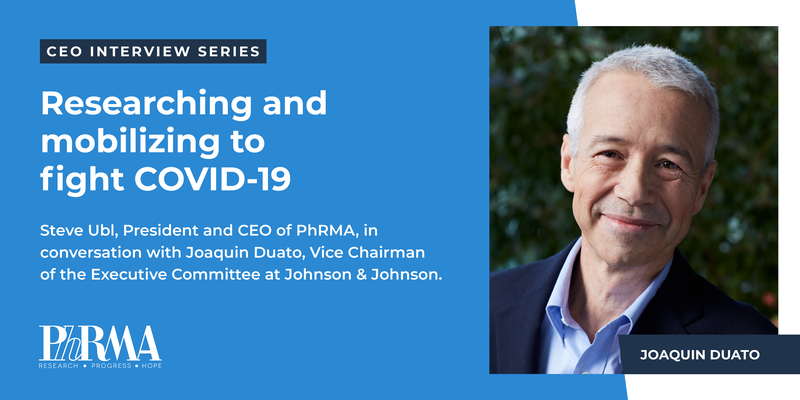 Over the last seven months, our industry has been working around the clock to combat the COVID-19 virus, including developing effective therapeutics to treat COVID-19 and vaccines to prevent future infections.
Over the last seven months, our industry has been working around the clock to combat the COVID-19 virus, including developing effective therapeutics to treat COVID-19 and vaccines to prevent future infections.
Last week, I had the opportunity to connect with Joaquin Duato, vice chairman of the executive committee at Johnson & Johnson, about the company’s efforts to fight COVID-19.
Stephen Ubl (SU): Joaquin, part of the reasons companies like Johnson & Johnson have been able to mobilize quickly is that you have established vaccine research programs. Can you talk a bit more about what learnings and resources you have been able to apply to speed the efforts here while ensuring safety?
Joaquin Duato (JD): This is a great question, Steve, as I recognize many of today’s readers are wondering how Johnson & Johnson and other companies are accelerating their vaccine development. For decades, Johnson & Johnson has actively engaged in fighting global outbreaks – from Ebola to TB and HIV. Our knowledge and experience, successes and set-backs alike, are informing everything we’re doing today to address COVID-19.
Our COVID-19 investigational vaccine candidate was created by inserting the SARS-CoV-2 spike protein into a “replication incompetent” or inactivated common cold virus. We use that inactivated virus as a carrier – a vector for the SARS-CoV-2 spike protein. The goal is for your body to be immunized against COVID-19. This technology is something we’ve been using for years to test investigational vaccine candidates for other diseases.
In fact, this platform is used in our Ebola vaccine, which was approved in early July by the European Commission and is currently deployed in the Democratic Republic of Congo and Rwanda. The platform also was used to construct our Zika, RSV and HIV investigational vaccine candidates. Our technology has been tested in more than 90,000 people to date.
Ultimately, while we are moving faster than the typical vaccine development process, I assure you that providing a safe and effective vaccine remains our number one priority.
SU: To ensure a vaccine is accessible once approved, what is needed for global collaboration? As advocates for patients, providers, pharmacists and other communities, what can each of us do to support that effort?
JD: I think one theme you are probably hearing ring true today is the critical importance of collaboration throughout the global public health community. This pandemic is an extraordinary experience, and it is energizing to see industry, governments and third-parties alike rising to this challenge.
Clearly, there are a lot of people in need of a COVID-19 vaccine around the world, so it will be in high demand once it is approved by regulatory authorities and becomes available. Our goal is to deliver a vaccine to the world and protect people everywhere from this pandemic, but we also recognize careful thought must be given to distribution to populations at greatest risk and where it could provide the greatest good according to our vaccine’s profile. This requires significant partnership throughout the global public health community.
At Johnson & Johnson, we are doing everything in our power now to prepare to meet this potentially huge demand. This is also why it’s so important to have more than one company working to develop a vaccine and for us to be holding hands across the public and private sectors. No one manufacturer can do this alone. And at the end of the day, we’re competing against COVID-19 – not each other.
In fact, just this week we joined our peer organizations in signing the COVID-19 Vaccine Maker Pledge, which reaffirms our commitment to developing a COVID-19 vaccine that meets high ethical and scientific standards. We hope this pledge will help ensure public confidence in the rigorous scientific and regulatory process we and other manufacturers are following in our vaccine work.
Beyond the global effort to develop, manufacture, and distribute a safe and effective vaccine, I am a firm believer that education is going to play a major role in driving access and uptake. Right now, we’re seeing that nearly 50% of U.S. adults are saying they wouldn’t be comfortable getting a COVID-19 vaccine even after it’s been approved by the Food and Drug Administration.
This is where the advocacy community can play a key role in helping ensure accurate information is available so that, upon approval, our communities will understand why vaccines are so important. We also are counting on the public health community to continue to advocate for those most impacted by the disease – helping ensure we can truly secure access for all.
SU: Can you talk a bit about your company’s work to combat COVID-19 beyond vaccine development? I know Johnson & Johnson has been very active in supporting front line workers.
JD: As the world’s largest healthcare company, we recognize the challenges our global community is facing in these unprecedented times. We are using our global reach, strong investment in R&D, deep scientific expertise and extensive partnerships to ultimately stop this virus in its tracks. Based on this, you could say that Johnson & Johnson was built for times like these.
We are putting the full power of our team to work in helping mitigate and ultimately end this pandemic in a variety of ways. We are prioritizing the safety and well-being of our employees, contractors and the communities in which we live and work. In addition, we are continuing to supply the critical medicines, devices and consumer health products customers and patients depend on.
We also are mobilizing to provide equipment, training, products and financial donations to support communities and healthcare workers on the front lines. In March, the Johnson & Johnson Family of Companies and the Johnson & Johnson Foundation committed $50 million dollars to support and supply frontline health workers. This commitment expands upon a $250 million multi-year commitment made earlier this year to support those at the front lines guided by the Johnson & Johnson Center for Health Worker Innovation.
Additionally, as I mentioned earlier, we are committed to bringing a safe and effective vaccine to the public on a not-for-profit basis for emergency pandemic use. To meet this commitment, we are expanding the Company’s global manufacturing capacity, including through the establishment of new U.S. vaccine manufacturing capabilities and scaling up capacity in other countries. We have also begun production at risk in parallel to conducting our clinical studies. We are working to address this crisis from every aspect of our business.
SU: How do you see health care industry as a whole changing due to the current pandemic? What lessons can we take away from this crisis?
JD: This crisis has reinforced the need for a strong, adaptive and innovative biopharmaceutical industry. And as new pandemics will continue to arise in the future, I anticipate we’ll see a greater focus in infectious disease treatments and vaccines in years to come across the healthcare industry – because this is an increasing area of unmet need. In fact, one of the lessons we’ve learned is that we need to work proactively to prevent these crises before they get out of hand. This is why Johnson & Johnson recently joined more than 20 distinguished industry partners to launch the Antimicrobial Resistance (AMR) Action Fund, which is investing nearly $1 billion with the goal of bringing two to four new antibiotics to patients by the end of the next decade. This the largest collective venture ever created to address AMR and a critical step forward in addressing this global challenge. We are acting together to solve the antibiotic innovation challenge, bridging the gap between science and patients to safeguard our future.
Second, while many companies like us already had embraced core digital technologies, like data science, intelligent automation and digital experience as enablers to better serve our patients and customers, this crisis has expedited these efforts and driven a profound increase in the role of digitization throughout our organization. In March, nearly 80 percent of our employees shifted to working from a home office environment instead of one of our facilities. This was a major change for our organization, as we have typically valued the personal connections and team building opportunities that meeting and collaborating in-person provides. So, we needed to work quickly with our technology partners to ensure our remote employees could have the support they needed and not skip a beat. At the same time, the crisis also sped up our reliance on our core digital technology capabilities as we worked to become more efficient across the board – and I anticipate the gains made in digital technology use during the crisis will have an enduring impact on our industry.
And lastly, I anticipate supply resiliency will remain a major focus for our company and our industry. There are millions of patients and billions of consumers who are counting on our innovative medicines, life-altering medical devices and trusted consumer health products. This was the case before COVID-19, and now, they are relying on us even more. As the pandemic is still in full force, we continue to take steps aligned with WHO and CDC guidelines that have been proven to keep our on-site employees healthy and well while they work to fulfill our commitments to those we serve. Because we have a global supply chain, we also saw that different parts of it were impacted at different times, which insulated our business from impact and allowed us to apply learnings from one market or region to another. I think it’s safe to say the coronavirus pandemic has helped us create a new playbook for how to ensure an uninterrupted of supply in the midst of a world-wide crises.
Johnson & Johnson and our industry partners have been rising to this challenge in new ways. Fortunately, we have a lot of best practices to reference moving forward, and overall, I’m excited to see what the future has in store for our industry in these three areas.
As always, you can stay up-to-date with the work the biopharmaceutical industry is doing to combat COVID-19 here.



 Over the last seven months, our industry has been working around the clock to combat the COVID-19 virus, including developing effective therapeutics to treat COVID-19 and vaccines to prevent future infections.
Over the last seven months, our industry has been working around the clock to combat the COVID-19 virus, including developing effective therapeutics to treat COVID-19 and vaccines to prevent future infections.